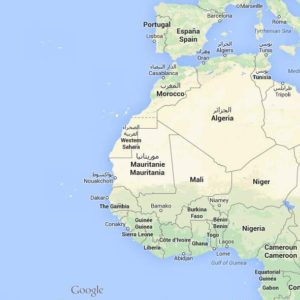 Bassikounou, Hodh Ech Chargui, Mauritania
Bassikounou, Hodh Ech Chargui, MauritaniaFall, 16 October 2006; 04:00 UTC
Ordinary chondrite, H5
Complete piece, 2574g
History:
A fireball was witnessed in the area, but no records of the direction of movement were recorded. A single stone of 3165 g was found by A. Salem El Moichine, a local resident, on the same day at 13:00 hr local time, 11 km SE of Bassikounou. The sample for classification was provided to NMBE by M. Ould Mounir, Nouakchott, who obtained it from his cousin who recovered the meteorite. According to S. Buhl (Hamburg, Germany), more than 20 specimens were later recovered by locals and meteorite finders. These finds define a 8 km long strewnfield. The total recovered mass is 46.00 kg.
Physical characteristics:
The 3165 g specimen is largely covered by black fusion crust. The interior is light gray. On the surface of the fusion crust there is some adherent soil material, some of which is bright red. Shortly after recovery, the stone was cut into two pieces of 1200 and 1950 g. The larger piece has a rectangular shape and shows indications of flow-lines in the fusion crust.
Petrography:
(E. Gnos, MHNGE; B. Hofmann, NMBE, M. Eggimann, Bern/NMBE): Mean chondrule size 0.35 mm (n=53). Metal abundance is 8 vol%, troilite 6.6 vol%. Mean plagioclase grain size is ~20 mm. Troilite is polycrystalline, rich in silicate inclusions, and shows diffuse boundaries to metal. Metal is partly rich in silicate- and troilite inclusions. Rare metallic Cu (10 mm) occurs at kamacite-taenite boundaries and in troilite. Some shock veins and no weathering products were observed.
Mineral compositions:
Olivine (Fa18.6), pyroxene (Fs16.3 Wo1.1), plagioclase (An13.7).
Cosmogenic radionuclides: (P. Weber, PPGUN) Gamma-spectroscopy performed in December-January 2006 showed the presence of the following radionuclides: 48V, 46Sc, 56Co, 54Mn, 58Co, 7Be, 51Cr, 57Co, 22Na, 26Al and 60Co. Recalculated to 12 October 2006 22Na was 38.0±2.2 and 26Al 31.5±2.1 (both dpm/kg), the activity ratio of 1.21 is fully consistent with a fall on that date.
Classification:
Ordinary chondrite (H5); S2, W0.
Type specimens:
A total of 115 g are on deposit at NMBE. Boudreaux holds the main mass.
A bright bolide of absolute magnitude -16±2 was widely seen over Argentina and Uruguay. The fireball was recorded by U.S. satellite visible-light sensors as reported by Douglas O. ReVelle (Los Alamos National Laboratory). A crude analysis of recorded infrasound data suggests a 0.01 kT event as analyzed by Peter Brown and Wayne Edwards (University of Western Ontario, Canada). The event occurred nearby the Argentina-Uruguay border. Eyewitnesses, interviewed by members of AEA and Gonzalo Tancredi (DAFC), reported that the fireball traveled from west to east and experienced several fragmentations along its trajectory causing audible detonations that shattered buildings in the area of fall. Several stones were found by members of Asociación Astronómica Entre Ríos a few days after the fall in the countryside around Colonia Berduc. The largest piece is a 154-g sample located in MNCNA-AS that acts as the hosting institution. The MLEDU museum has a 95-g piece, and CASLEO has a piece of 21 g. The rest of the mass remaining in Argentina is in private collections.
Specimen Description:
A nice stone with fresh black crust and some thumb prints. One side is broken in the impact hit to the ground
References:
Meteoritical Bulletin Database
Jarkko Kettunen Meteorite Collection © 2024
